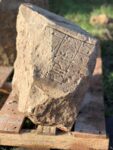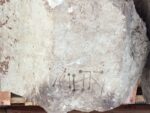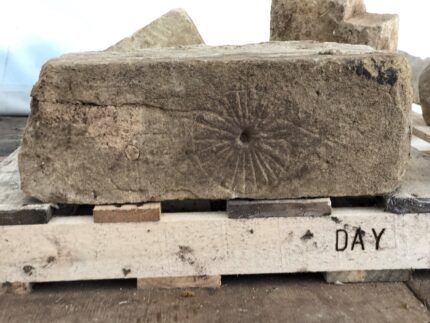Archaeologists have discovered “witches’ marks” on the remains of the medieval church of St Mary the Virgin in Stoke Mandeville, Buckinghamshire, England. Two stones were found that were engraved with a symbol of a circle containing lines radiating from a central drilled hole. These are believed to be witches’ marks, symbols of apotropaic magic that ward off harm and malign influences by entrapping them in a maze. Similar signs have been found on buildings all over Britain, and in some cases can be reasonably interpreted as sundials use to keep time in church. The St Mary’s marks, however, were found in the walls of the west buttress practically at ground level. There was no sun going to be hitting that stone to make it work as a timekeeper.
The team has been excavating the site of the long-demolished church to salvage any archaeological and human remains from the church’s burial ground in advance of construction of the HS2, a new high-speed railway connecting London to Scotland and 25 stops in between.
Detailed research into the structure of the church has allowed archaeologists to piece together a history of the development of St Mary’s. The church started off as a chapel built in about 1070, shortly after the Norman Conquest and may have been at first the private chapel belonging to the lord of the manor at that time. The church was soon extended, and an aisle added in the 1340s. These new additions seem to mark a transition from a chapel used for private prayer to a church that was used by the local villagers.
 The church was replaced with a red brick parish church in the village proper in 1866 and the old one on the outskirts of town fell into disrepair. It was condemned in the 20th century and demolished in 1966. Unfortunately the demolition was not documented at the time, so archaeologists had no idea what might be left of the church. Much to everyone’s surprise, a significant section of the 14th century church was still there. The floors are intact and the walls stand almost five feet high.
The church was replaced with a red brick parish church in the village proper in 1866 and the old one on the outskirts of town fell into disrepair. It was condemned in the 20th century and demolished in 1966. Unfortunately the demolition was not documented at the time, so archaeologists had no idea what might be left of the church. Much to everyone’s surprise, a significant section of the 14th century church was still there. The floors are intact and the walls stand almost five feet high.
The entire church is now being excavated and carefully dismantled. Work is expected to continue into 2021, and they may find even more once of the medieval remains have been raised, for example a Saxon church that may have existed on the site before the Norman chapel was constructed.
 HS2 will be hosting a webinar on the archaeological finds at St Mary’s on Wednesday, October 28th, at 12:15 GMT. If you can attend live, you can ask the archaeologists questions via chat. The session will also be recorded and posted on HS2’s YouTube channel after it airs. There are several previous webinars about the archaeology of the HS2 already uploaded to the channel.
HS2 will be hosting a webinar on the archaeological finds at St Mary’s on Wednesday, October 28th, at 12:15 GMT. If you can attend live, you can ask the archaeologists questions via chat. The session will also be recorded and posted on HS2’s YouTube channel after it airs. There are several previous webinars about the archaeology of the HS2 already uploaded to the channel.
See the church rebuilt in this CGI rendering:

HS2, for those who don’t live in this septic isle, is like so many grand schemes: a taxpayer-funded ego trip by politicians. Despite the fact that the rest of the rail network needs the funding, they are spending billions,destroying countless acres of farmland, woodland, historic sites like this and anything else which stands in their way. The final achievement will be several minutes off the London to Birmingham rail journey and very little else.
Perfectly suitable for witchcraft on the outside of a church to match the nonsense being peddled on the inside – harmonious!
mccxii This yere of oure lord an eretyk was brent for eresye, the whiche be craft quenchyd ofte the fire.
mccxx Firy dragons were seyne.
mccxiii in this yere upon seynt Lukes day there blew a gret wynd out of the north, whiche caste doune manye houses, steples and torrettes of chirches, and turned up so downe trees in wodes and in orchardes, at whiche tyme fyry dragons and wykkes spirytes grete noumbre were seyn openly fleyng in the eyre.
—-
Apotropaic magic by entrapping them in a maze. Ἄποτρέπειν “to ward off”, from από- “away” and τρέπειν “to turn”, ἀποτρόπαιος (apo-trópaios) “warding off”.
–OK, it probably works, as I really feel entrapped now :confused:
On the other hand, the stone with the circle and hole could have been reused from a previous location where the carving could have been used as a sun dial. However, there is no point in a 360 degree circle for a sundial unless it is located above the Arctic Circle and used to measure the midnight sun.
Then why even bring it up?
A very rudimentary mill stone?